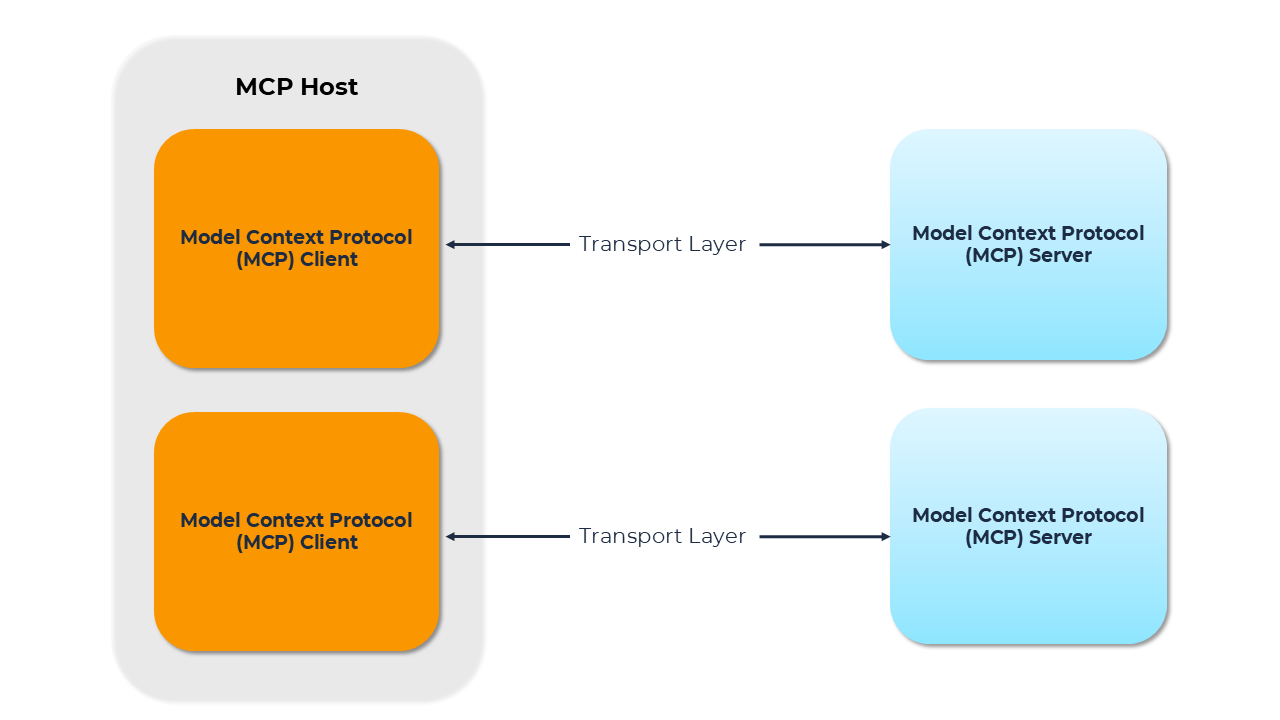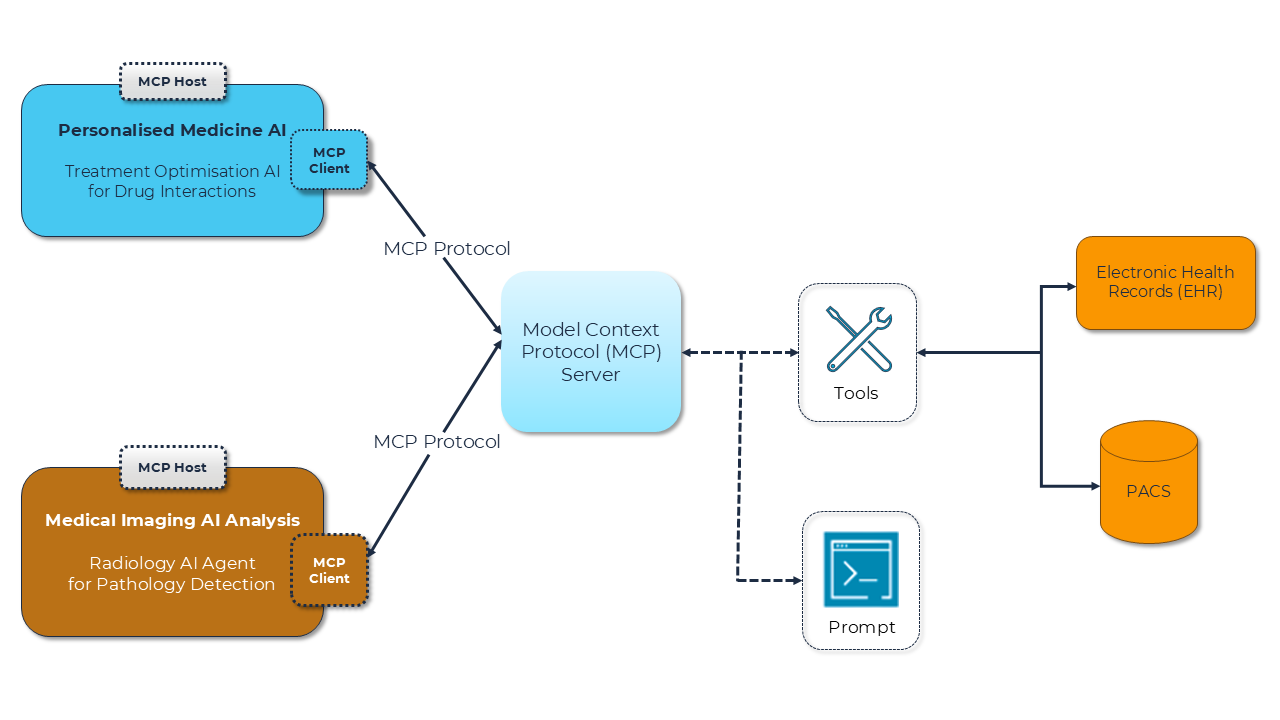Enterprise integration is a complex challenge that requires seamless communication between disparate systems, applications, and data models. The Model Context Protocol is a new standard that promises to transform how AI systems integrate with existing business infrastructure.
Large Language Models (LLMs) used by AI Agents and AI workflows are increasingly becoming commonplace in enterprises. They bring a reliable, integrated experience that improves productivity. To deliver on their promised benefits, these AI systems need to integrate with legacy systems, custom-built systems, and SaaS products used within the enterprise ecosystem.
The Model Context Protocol (MCP) represents a new pathway in enterprise integration architecture, offering opportunities for seamless AI-driven workflows while addressing critical challenges that have long plagued enterprises.
Some of those include:
- Defining and maintaining contextual relationships between data models
- Ensuring semantic interoperability between or across integrating systems
- Decoupling integration logic from business logic
By the end of this article, you’ll understand how MCP facilitates integration scenarios for AI-driven enterprise workflows, while also eliciting deeper conversations and considerations for using MCP as a viable means for enterprise integration using AI Agents.
What is Model Context Protocol (MCP)?
The Model Context Protocol is an open standard designed to enable secure, standardised communication between AI models and external data sources, applications, and services. Unlike traditional integration approaches that require custom APIs and complex middleware solutions, MCP provides a unified framework for AI systems to access and interact with enterprise resources in a consistent, predictable manner.
At its core, MCP establishes a standardised way for AI models to understand context from various enterprise systems whether that’s customer data from CRM platforms, financial information from ERP systems, or operational metrics from monitoring tools. This protocol acts as a universal translator, allowing AI models to seamlessly consume and process information from disparate sources without requiring extensive custom development work.
How does MCP work?
MCP operates by establishing a contextual mapping layer between different data models.
Here’s a simplified breakdown:
Model Definition
Each system or domain defines its own data model (e.g., Customer, Order, Product).
Context Mapping
MCP creates a context-aware mapping that translates between models without requiring a rigid, unified schema.
Protocol Enforcement
Rules and transformations are applied dynamically based on the interaction context.
Execution & Mediation
MCP facilitates communication between systems while preserving each model’s autonomy.
This approach avoids the challenges of traditional point-to-point integration, where changes in one system often require updates in another.
Key Concepts in MCP
MCP is built on a flexible, extensible client-server architecture. To better understand how it fits within a real-world enterprise integration scenario, let’s go over the key concepts put forward by the protocol.
Hosts are AI applications or AI models that initiate connections.
Clients are inside the host application which maintain connectivity by adhering to MCP protocol.
Servers provide context, tools, and prompts which Hosts can utilise.

The MCP Server provides following key capabilities:
Resources
Resources are a core primitive in the Model Context Protocol (MCP) that allow servers to expose data and content that can be read by clients and used as context for prompts.
Prompts
Prompts enable servers to define reusable prompt templates and workflows that clients can easily surface to users, they are designed to be user-controlled. They give users ability to explicitly select them.
Tools
Tools are a powerful primitive in the Model Context Protocol (MCP) that enable servers to expose executable functionality to clients, they are designed to be model-controlled. This allows the AI model to invoke them on behalf of the user.
Key Principles of MCP
Shared Canonical Models
Define and distribute canonical models that represent key business entities (Customer, Invoice, Product) along with their context (source, state, ownership).
Contextual Contracts
Every service that emits or consumes data adheres to a contract that includes not just the structure of the model but its intended usage, lifecycle state, and meaning.
Model Registries
A central repository or registry governs model definitions, versioning, and backward compatibility, ensuring a single source of truth.
Context Propagation
Metadata about the model context (e.g., who transformed it, why, in what process stage) travels alongside the payload in APIs, event streams, or service calls.
Decentralised Governance
While the models are standardised, teams retain the autonomy to extend them for local needs—within guardrails defined by the protocol.
MCP-Enabled Healthcare Integration – Sample Integration Architecture

This image above is an example of how MCP can be leveraged to enable integration between source systems of different data models and schemas and AI-enabled outcomes like personalised medicine or medical imaging.
The MCP Server acts as the authoritative source of truth for canonical models e.g. patient. It holds the model registry and provides model definitions, version metadata, and context schemas.
The MCP Server leverages tools for modifying and querying data from Electronic Health Records (EHR) and Picture Archiving and Communication System (PACS) for the MCP Host to use.
The MCP Hosts make use of purpose-built MCP Clients that use Prompts and actions published by the MCP Host to seamlessly modify and query data from the downstream systems.
Why is MCP significant in Enterprise Integration for AI?
Enables Loose Coupling:
MCP reduces dependencies between integrated systems, allowing them to evolve independently. This is crucial in microservices and distributed architectures where change is constant.
Supports Semantic Interoperability:
Different departments (Sales, Finance, Logistics) often use the same terms (e.g., “Customer”) with different meanings. MCP ensures that data is interpreted correctly in each context. Unified data models reduce ambiguity and integration errors.
Simplifies Scalability by Introducing Change Resilience:
Since MCP decouples integration logic, adding new systems or modifying existing ones becomes easier without cascading changes across the enterprise. Loose coupling via context-aware contracts protects against upstream changes thereby adding change resiliency.
Reduces Integration Technical Debt:
With Unified Data Models and model registry MCP avoids proliferation of bespoke transformations and mappers thereby promoting more adaptive and sustainable models for integration.
MCP Implementation Considerations for Enterprises
While MCP offers significant benefits, successful implementation requires careful planning and consideration of several factors:
Infrastructure Readiness
Organisations must assess their current infrastructure’s readiness for MCP implementation, including network capacity, security frameworks, and data governance policies.
Change Management
Implementing MCP may require changes to existing workflows and processes. Organisations should plan for appropriate change management and training programs.
Performance Optimisation
While MCP standardises integration approaches, organisations must still optimise performance for their specific use cases and data volumes
Vendor Ecosystem
The success of MCP implementation often depends on vendor support and ecosystem development. Organisations should evaluate the MCP readiness of their existing technology stack.
Conclusion
The Model Context Protocol represents a thoughtful evolution in integration strategy when it comes to integrating with AI systems with AI workflows and AI Agents. Rather than connecting these systems the traditional way, MCP guarantees that shared understanding and context are first-class citizens of the integration architecture.
For organisations aiming to scale integration efforts, reduce fragility, and unlock agility, MCP might be the perfect solution in the integration architectural toolkit.
By adopting MCP, organisations can achieve:
- Greater agility in system integration
- Reduced maintenance overhead
- Improved interoperability across domains
As enterprises continue to embrace cloud-native, distributed systems, MCP will play an increasingly vital role in ensuring seamless and scalable integration with AI systems.
References:
Anthropic. “Introducing the Model Context Protocol.” Anthropic.com, 2024, www.anthropic.com/news/model-context-protocol.
“Introduction – Model Context Protocol.” Modelcontextprotocol.io, Model Context Protocol, 2025, https://modelcontextprotocol.io/introduction.
“Resources – Model Context Protocol.” Modelcontextprotocol.io, Model Context Protocol, 2025, https://modelcontextprotocol.io/docs/concepts/resources.
“Tools – Model Context Protocol.” Modelcontextprotocol.io, Model Context Protocol, 2025, https://modelcontextprotocol.io/docs/concepts/tools.



















